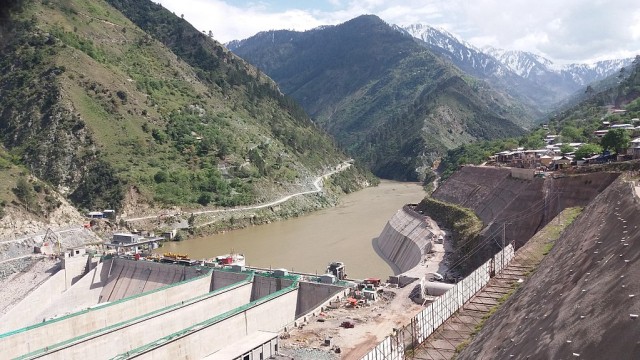Understanding the role of Water in India’s occupation of Kashmir

Image from Swarajaya
Kashmir’s lakes and rivers, especially the waters of the Indus River system, make up part of the stunning backdrop to the diverse indigenous peoples and wildlife who call Kashmir home. For Kashmir’s settler colonial occupiers, however, wielding control over Kashmir’s rivers is yet another way to cement their control over the region, to steer water flows against rival Pakistan, and to displace indigenous people and their systems of knowledge. We must center the needs of Kashmiris to utilize water over Indian attempts to extract water and use water for geopolitical gains.

Jhelum River. Image: WIONews.
India’s desire to control water and waterways in Kashmir contributes to the suppression of Kashmiri self-determination. For decades, India and Pakistan have considered Kashmir and water in Kashmir as a vital resource. In 1960, India and Pakistan signed the Indus Waters Treaty (IWT), which provided that the waters of the westernmost rivers of the Indus system would be apportioned to Pakistan, while those of the easternmost rivers would in turn be utilized by India. The IWT also, however, allowed states whose territory the rivers passed through to utilize the water for certain non-consumptive purposes, such as hydropower, regardless of whether they had rights to the rivers’ water. Political control over Kashmir thus includes control over the source of two Indus tributaries, the Jhelum and the Chenab.
Attempts to exert control over Kashmir are simultaneously attempts to utilize Kashmir’s water resources for political control. India has manipulated the nonconsumptive use provisions in the IWT to exert power over flows of the western rivers into Pakistan. Thus, Kashmir represents an important region for India to gain political dominance in South Asia through control of waterways into Pakistan. Pakistan claimed that India’s building of the Kishanganga Dam in the early 2010s was an affront to Pakistan’s sovereignty that placed extortionate control of Pakistan’s water flow in the hands of India, while India argued that the dam presented an opportunity for capitalist economic development. These tensions continued into India’s August 2019 decision to release significant discharges on the Sutlej River into Pakistan just as India removed Kashmir’s constitutional protections. Noticeably absent are the people of Kashmir, who in many cases have contributed their labor to infrastructure projects.
Kashmir’s water in lakes and glaciers also presents a potential source for India to maintain its integration into global economic systems and sustain rapid population growth. Increased pressures on India’s water supply and extreme weather events in India such as larger monsoons mean that India must find a new water supply to survive. That supply has been identified as Kashmir. As extreme weather events, shifting weather patterns, and new stresses on land use result from global climate change, India will continue to look to Kashmir to provide for India’s growing population and changing ways of life.

The Threat to Kashmir’s glaciers. Image: Reuters
Militarization in Kashmir’s fragile landscape coupled with the effects of climate change threaten Kashmir’s glaciers in particular.
Kashmiris today must grapple with the outcomes of extractive ideologies as their ways of life are disrupted by climate change and the settler colonial project. Kashmir is the home to ample water supplies in glaciers and rivers, but the occupation has cut most Kashmiris off from water resources and their indigenous lifestyles which sustainably utilized water.
Over the past few years, cities and villages in Kashmir have experienced shortages of drinking water and rice farmers in Kashmir have been asked to temporarily stop cultivating rice paddies. These actions have been met by outcry from Kashmiris who demand suitable infrastructure and irrigation systems. Indian control of Kashmir’s water also threatens the indigenous lifestyles and cosmologies of Kashmiris. According to anthropologist Mona Bhan, Indian hydropower corporations have paternalistically claimed that the indigenous Gurezis of Kashmir are “lazy” for expressing uncertainty and anxieties about building infrastructure for the occupying power and losing their ways of life. Meanwhile, Kashmiris have lost their lives working for hydropower companies and while repairing wells. While huge infrastructure projects consolidate India’s power in Kashmir and in South Asia, Kashmiris suffer from a lack of investment and the loss of water resources.
Make no mistake: the water issues that Kashmiris face are an issue both of environmental justice and of the settler colonial project. India has wielded control of water in Kashmir for its own political gain at the expense of indigenous people and their lifestyles, and subjected them to health hazards and paternalistic discourses to suppress their resistance.
References
Majed Akhter, “Adjudicating infrastructure: Treaties, territories, hydropolitics,” Environment and Planning E: Nature and Space 2 no. 4 (Dec. 2019): 831–849.
Mona Bhan, “Morality and Martyrdom: Dams, Dharma, and the Cultural Politics of Work in Indian-Occupied Kashmir,” Biography 37 no. 1 (Winter 2014): 191–224.
Bisma Bhat, “Water crisis hits Kashmir, authorities in slumber,” The Kashmir Monitor, July 8, 2020, https://www.thekashmirmonitor.net/water-crisis-hits-kashmir-authorities-in-slumber/
M. R. Elahi, “Handwara villagers decry lack of drinking water,” Kashmir News Service, July 11, 2020, http://www.knskashmir.com/news.aspx?news=Handwara-villagers-decry-lack-of-drinking-water-48450
Daniel Haines, Rivers Divided: Indus Basin Waters in the Making of India and Pakistan (New York/Oxford: Oxford University Press, 2017).
Harjot Kaur, “Weaponizing Water in Kashmir,” Legal Planet, September 10, 2019, https://legal-planet.org/2019/09/10/weaponizing-water-in-kashmir/
Mehr Nadeem et al., “Pakistan, India Spar Over Using Water As A Weapon in Kashmir,” August 19, 2019, The Wire, https://thewire.in/diplomacy/pakistan-india-spar-over-using-water-as-a-weapon-in-kashmir-dispute
Athar Parvaiz, “Kashmir water crisis hits at its staple: rice,” The Third Pole, April 17, 2018, https://www.thethirdpole.net/2018/04/17/kashmir-water-crisis-hits-at-its-staple-rice/
Nawal Watali, “Dwindling water supply, ‘smelly’ drinking water is making people sick in Kashmir,” Free Press Kashmir, July 14, 2020, https://freepresskashmir.news/2020/07/14/dwindling-water-supply-smelly-drinking-water-is-making-people-sick-in-kashmir/
©2025 StandWithKashmir All rights reserved. SWK is a 501(c)(3) non-for-profit organization.


Leave a Reply